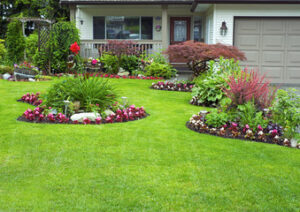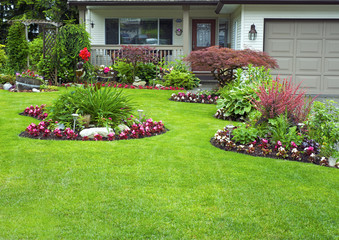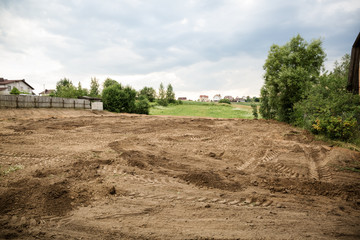Landscaping is the artistic arrangement of horticultural plants and built features like patios, pathways, walls, water features, and lighting. It combines creativity and science to create harmonious outdoor environments that reflect your personality and serve practical needs. Visit https://www.primecutlawnky.com/ to learn more.
Unity: Using similar plant species throughout the garden can cultivate a sense of unity. Contrasting shapes, sizes, and colors can also draw the eye in a particular direction.
A lush green lawn is an ideal that is deeply ingrained in societal expectations, as evidenced by the ubiquity of advertising, real estate marketing and popular culture. While a well-maintained lawn can improve the beauty of a home, it is also a valuable asset to a property’s value and provides many ecological benefits.
But, a beautiful and well-managed lawn doesn’t necessarily have to be a monoculture of a single variety of turf grass; introducing native species or even ornamental weeds into the yard can create an attractive and healthy landscape. When properly managed, native plant landscaping is often easier to maintain than traditional grass lawns.
Lawns that are mowed too short and/or are subjected to excessive fertilizer and chemical usage will quickly become unruly and invasive, which can result in costly maintenance and damage to the environment. The use of pesticides, fungicides and herbicides to maintain these kinds of lawns contaminates water supplies and harms local wildlife. The water used to water lawns exacerbates the problems of water scarcity in many areas, and regular mowing releases greenhouse gases that contribute to global climate change and Earth’s overshoot.
Grass absorbs rainwater and reduces stormwater runoff, which can help prevent flooding and pollution of lakes, rivers and other water bodies. In addition, it helps to improve water quality by reducing the amount of nutrients that reach groundwater sources.
As an added benefit, the dense structure of a natural lawn can act as a noise filter, helping to muffle sounds from neighbors, traffic and other nearby sources. This is an important feature for neighborhoods with a lot of foot traffic.
Grass provides food for bees, butterflies and other pollinators, as well as a habitat for small mammals and birds. It is an important part of a healthy ecosystem, and many plants commonly considered as weeds (dandelion, clover, violets) are vitally important to wildlife as well. Many of these plants are good for the soil, too, and provide nitrogen, phosphorous and other essential nutrients. However, if these plants are removed from the landscape and replaced with non-native grasses, the lawn can no longer provide these benefits.
Shrubs
Bushes are woody plants that branch into multiple stems and do not have a single trunk. They are bigger than herbs but smaller than trees and are commonly used in the landscape to add structure, color, texture, and privacy. Shrubs are an important part of a garden’s design and should be carefully selected for their mature size, shape, and form. There are many forms of shrubs to consider when creating a landscape. Each shape offers a different effect on the garden’s look and feel.
Round-shaped shrubs, like boxwoods and dwarf Korean lilacs, are ideal for creating low hedges or borders. They offer softness and balance to the landscape and help to break up the angular lines of a fence or house. Other options include azaleas and rhododendrons, which offer spring flowers and attractive evergreen foliage. Forsythia is another great flowering shrub that provides beautiful, yellow blooms in the spring.
Shrubs with textured foliage also add interest to the garden. Some are silvery-blue or chartreuse, while others have variegated or striped foliage. They can be used as backdrops for other plantings or in front yards to create focal points for entryways, pathways, and seating areas.
Many shrubs work well in a formal garden, particularly those with symmetrical growth patterns. They can be crafted into geometric shapes to create neat hedges and borders or intricate parterres, adding structure and formality to the landscape. The right shrub can also act as a living wall to offer privacy and protection from the sun or wind. Columnar or cone-shaped shrubs are good choices for this purpose, as are holly and arborvitae.
When selecting shrubs, it is important to take into account the color scheme of the landscape as well as the colors of the surrounding buildings and structures. This will help guide the selection of colors, leaf texture, blooming times, and fall color for the shrubs. It is also a good idea to choose native shrubs when possible, as these will be better adapted to the local climate, soil, and growing conditions. This will save money in maintenance costs and the use of fertilizers and pesticides while also helping to protect the environment.
Trees
Trees provide natural shade and comfort, improving outdoor living spaces. Trees also improve air quality, enhance privacy, and reduce noise pollution on properties, adding to the livability of homes. Trees, with their varying shapes, foliage colors and textures, offer visual interest throughout the seasons and add depth and beauty to landscapes.
Incorporating a variety of trees into the landscape helps support local wildlife, as they offer essential habitat and food sources for birds, squirrels, insects, and other species. In addition, the roots and soil of trees help to stabilize soil and prevent erosion. The natural shade and air flow created by trees help to moderate the temperatures of outdoor spaces, reducing energy costs.
Specimen trees act as focal points in the garden narrative, drawing the eye and serving as a centerpiece to the overall design of the garden. Trees can also be used as a screening element, blocking unwanted views. The choice of tree species depends on many factors, including climate, aesthetic preferences, and maintenance needs. Some trees are prone to disease and pests, so it is important to select tree species that have resistance or tolerance for common issues.
Aesthetic preferences include the shape, size, and color of the foliage. Evergreen trees are effective in creating a windbreak and offering privacy, while deciduous trees can be planted to serve as an attractive summer feature. The width or spread of a tree is also an important consideration. Some newer conifers have narrow forms that take up very little space and can be effectively planted in tight spaces.
The varying shapes of trees can be used to soften the architecture of houses, especially when placed at the corners of two-story and walkout homes. In addition, a tree can break up the flat plane of an architectural roof to create a more dramatic visual impact.
A variety of flowering trees can be planted for spring blooms, and fruit-bearing trees such as plums and peaches are popular in northern climates. Other seasonal highlights can be created with trees like thorny holly, spruce, and fir for winter interest.
Irrigation
Irrigation is an essential component of landscaping that ensures all plants get the water they need. A well thought out irrigation plan helps conserve water and prevent runoff, which reduces soil erosion and pollution from fertilizers that can flow into our local waters.
A landscape’s water needs are complex and variable depending on the time of year, weather, soil conditions and plant species. Proper irrigation systems use a combination of sprinklers and tubes to deliver the right amount of water based on your specific landscape, avoiding overwatering and wasting water.
Regularly checking your irrigation system ensures that all zones are receiving the correct amount of water, which protects your investment in a beautiful landscape. It also helps prevent soil erosion and promotes healthy root growth by reducing stress from overwatering or underwatering.
Landscape irrigation is used to irrigate ornamental vegetation, sports fields and golf courses, parks, cemeteries, and residential gardens and yards. It also is a valuable resource to protect and enhance the quality of drinking water by removing pollutants from surface water through nutrient uptake by plants.
Irrigation has been used for agriculture in many parts of the world for over 4,000 years. In what is now the United States, prehistoric desert agriculture was accomplished by brush dams that captured and diverted water flow from dry arroyos, flooding fields to hydrate crops.
Surface irrigation uses a garden hose, hand watering or a sprayer attachment on a nozzle to apply water to the surface of the soil. This method is inefficient and inconsistent because it relies on homeowners or landscaping professionals to manually water the property. It can also result in water puddles and parched areas because it often misses the root zone of the plants.
Drip irrigation uses a network of plastic tubing to deliver water directly to the root zone of the plant. It is a more efficient way to water because it applies the water at a slow rate over an extended period of time. This allows the water to soak into the soil rather than running off and evaporates with wind or sun. It is also very flexible because it can be adjusted to meet the specific needs of each plant type.

 One of the most obvious benefits of land clearing is the creation of additional usable space. Cleared land can be used for a variety of purposes, including growing gardens and trees, installing playgrounds or outdoor workspaces, and constructing buildings or homes. Adding additional land to your property also increases its value and can make it easier to sell in the future.
One of the most obvious benefits of land clearing is the creation of additional usable space. Cleared land can be used for a variety of purposes, including growing gardens and trees, installing playgrounds or outdoor workspaces, and constructing buildings or homes. Adding additional land to your property also increases its value and can make it easier to sell in the future.